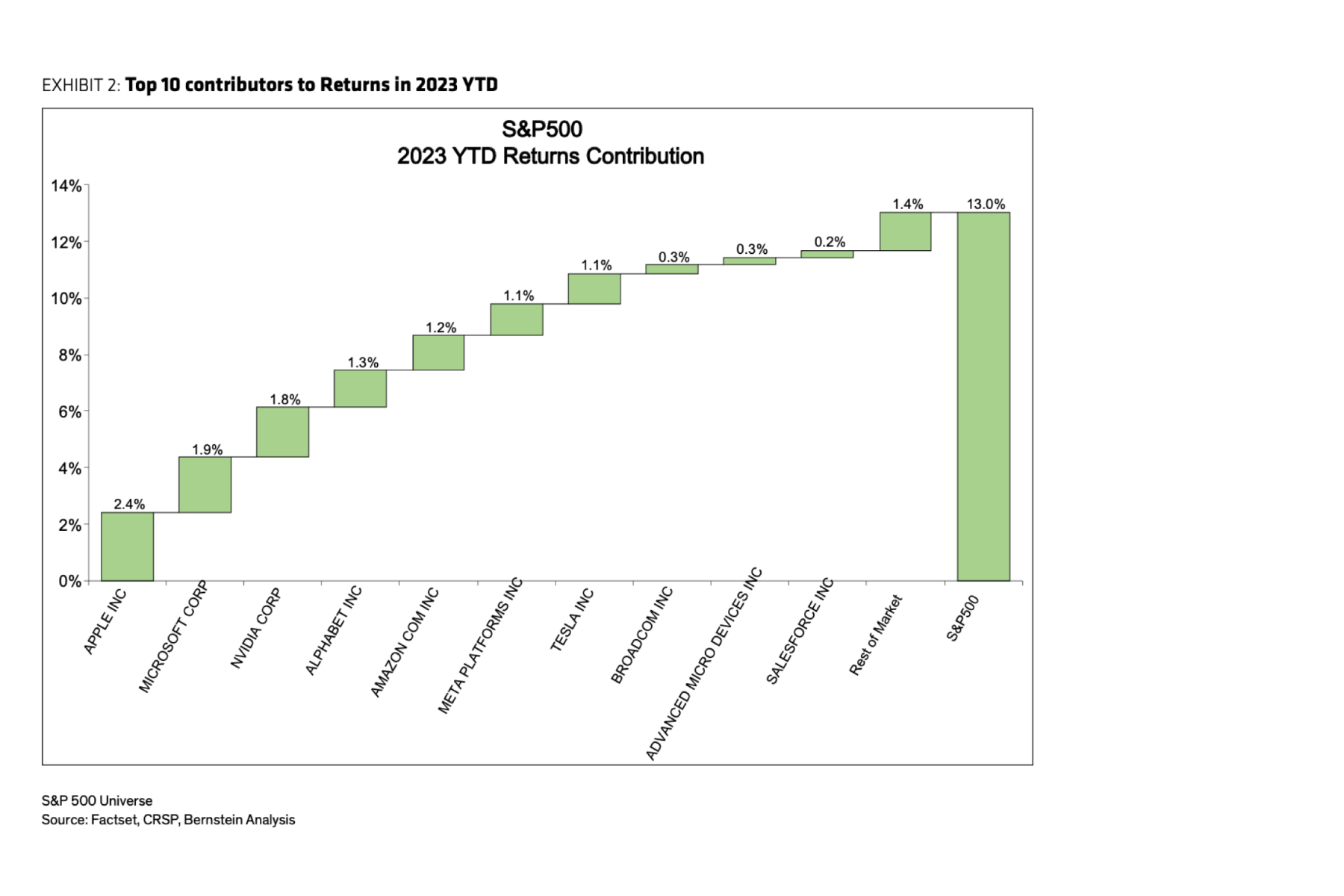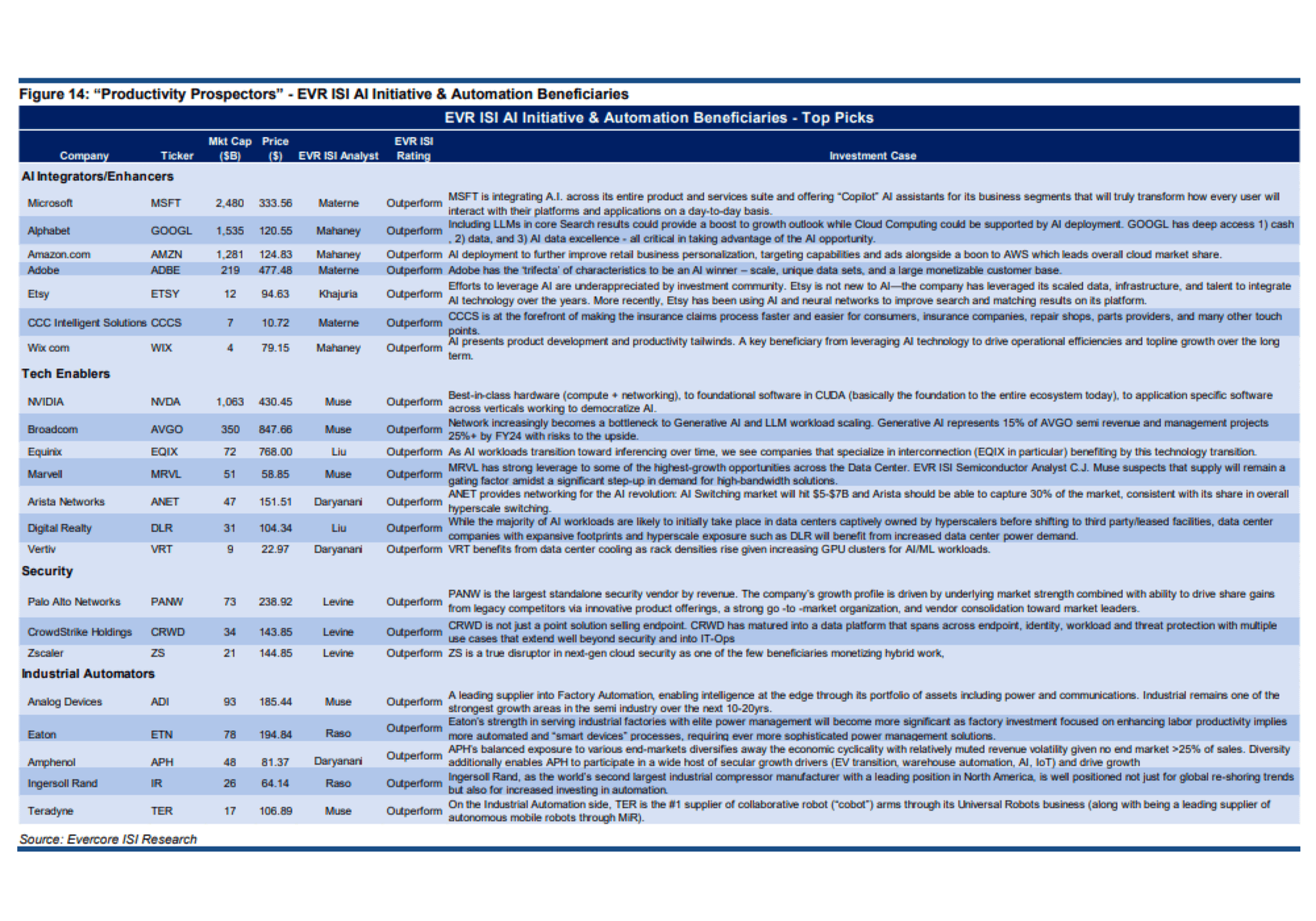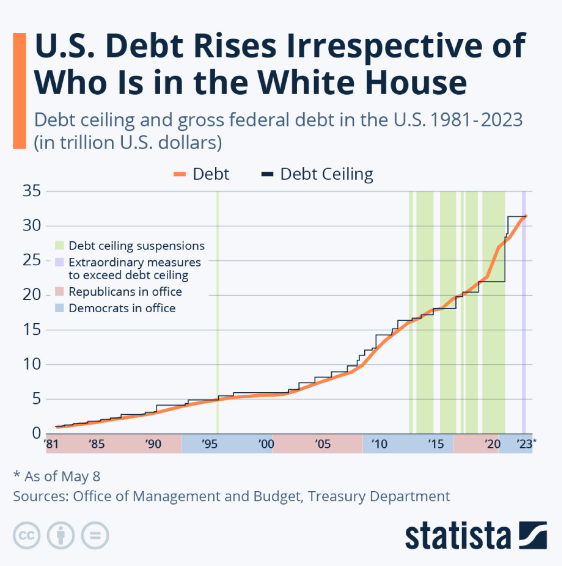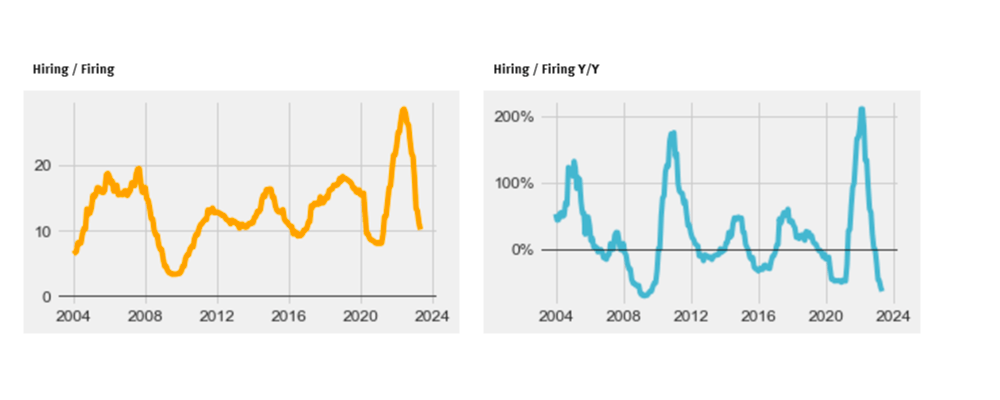Get Connected
With the arrival of June, we welcome summer. Two other words that do not sound so bad to investors are “positive markets.” As of Friday, the S&P 500 is up roughly 14% year-to-date which brings it approximately 9% off the all-time highs seen in early 2022. During the market decline in 2022, we wrote several times about how the underlying stocks in the market were significantly worse than the overall market appeared. Once again, the performance in the S&P 500 is deceiving.
Market Concentration.
Much is usually written about portfolio diversification. It is still a very important tool in balancing risk and reward and helping investors reach their long-term goals. As seen in the table below, the top 10 contributors (through mid-June) accounted for nearly 90% of the S&P 500’s year-to-date return, while the remaining, roughly 490 stocks contributed a measly 1.4%. This has made the year much more challenging for professional investors as the performance of the market has been highly concentrated (even more so than mentioned in our previous newsletter). What makes this a bit concerning is that this performance was driven by multiple expansion (i.e. positive sentiment) versus an increase in earnings expectations…

…a big contributor to this has been the excitement in Artificial Intelligence (AI).
Artificial Intelligence (AI).
There has been a continued focus in this area of the market and the excitement and hope is warranted as several companies have reported above consensus expectations due to better growth driven by demand for AI products. With the labor costs continuing to be stubbornly high and unemployment still very low, we do believe AI will be an important factor in fighting inflation. Below we came across an interesting table of companies published by Evercore ISI Research that highlighted companies that could be beneficiaries of this trend…some more directly so than others

Debt.
While a government default was averted by an 11th hour deal, no solution was provided to the country’s debt situation. The chart below shows that there likely is not going to be a real resolution to this regardless of who is in office in 2024, but it is something that will need to be addressed by the next president.

The biggest takeaway from this sharp increase in debt is that real GDP has been 1.6% since the Great Financial Crisis while in the 70 years prior to that, it was 3.1%. While the “kick the can down the road” strategy has been moderately successful in avoiding recessions, this slower growth environment has been the price we have paid. The debt issue is something we will address more in depth in the future.
What do we think about the 2H?
One of the recent surveys we read mentioned that 100% of those surveyed believe that a recession is likely in the coming quarters. Consensus has shifted to expectations of a moderate recession as the economy, thus far, has proven to be resilient despite the sharp increase in rates over the last 12 months and the bank crises in March which have significantly tightened lending conditions. With one or two rate increases remaining in 2023 already expected, we start to think about the opportunity in the second half to be driven by the anticipation of rate cuts in 2024. Unemployment is a key focus for the Fed and analysis of the most recent quarterly earnings calls shows a sharp decline in hirings/firings.

So, over the next several months we lean towards longer duration fixed income and while the bar has been set higher for the larger companies as expectations have increased due to AI, we expect the opportunity to be in a potential recovery of the broader market which may not necessarily yield a significantly higher S&P 500, but a more balanced one.
Let our experienced investment team guide you on your journey to growing and protecting your wealth. Contact us today to begin a conversation.
Quick Links
Contact Details
IMPORTANT DISCLOSURES
Bergamot Asset Management LP (“Bergamot”) is registered with the state of New Jersey as an investment adviser located in Princeton, New Jersey. Bergamot and its representatives are in compliance with the current notice filing requirements imposed upon registered investment advisers by those states in which Bergamot maintains clients. Bergamot may only transact business in those states in which it is registered or qualifies for an exemption or exclusion from registration requirements. Bergamot’s web site is limited to the dissemination of general information pertaining to its investment advisory services. Accordingly, the publication of Bergamot’s web site on the Internet should not be construed by any consumer and/or prospective client as Bergamot's solicitation to effect, or attempt to effect transactions in securities, or the rendering of personalized investment advice for compensation, over the Internet. Any subsequent, direct communication by Bergamot with a prospective client shall be conducted by a representative that is either registered or qualifies for an exemption or exclusion from registration in the state where the prospective client resides. For information pertaining to the registration status of Bergamot, please contact the state securities law administrators for those states in which Bergamot maintains a notice filing. A copy of Bergamot's current written disclosure statement discussing Bergamot's business operations, services, and fees is available from Bergamot upon written request. Bergamot does not make any representations or warranties as to the accuracy, timeliness, suitability, completeness, or relevance of any information prepared by any unaffiliated third party, whether linked to Bergamot's web site or incorporated herein, and takes no responsibility therefor. All such information is provided solely for informational/convenience purposes only and all users thereof should be guided accordingly. Registration of an Investment Adviser does not imply any level of skill or training.
Each client and prospective client agrees, as a condition precedent to his/her/its access to Bergamot’s web site, to release and hold harmless Bergamot, its officers, directors, owners, employees and agents from any and all adverse consequences resulting from any of his/her/its actions and/or omissions which are independent of his/her/its receipt of personalized individual advice from Bergamot.
The information contained herein reflects the opinion and projections of Bergamot as of the date of publication, which are subject to change without notice at any time subsequent to the date of issue. Bergamot does not represent that any opinion or projection will be realized. All information provided is for informational purposes only and should not be deemed as legal, tax, investment advice or a recommendation to purchase or sell any specific security. This shall not constitute an offer to sell or the solicitation of an offer to buy any interest in any fund managed by Bergamot or any of its affiliates. While the information presented herein is believed to be reliable, no representation or warranty is made concerning the accuracy of any data presented. Market conditions can vary widely over time and can result in a loss of portfolio value. Past performance does not guarantee future results.
All Rights Reserved | Bergamot Asset Management LP | Privacy Policy | Terms of Use
